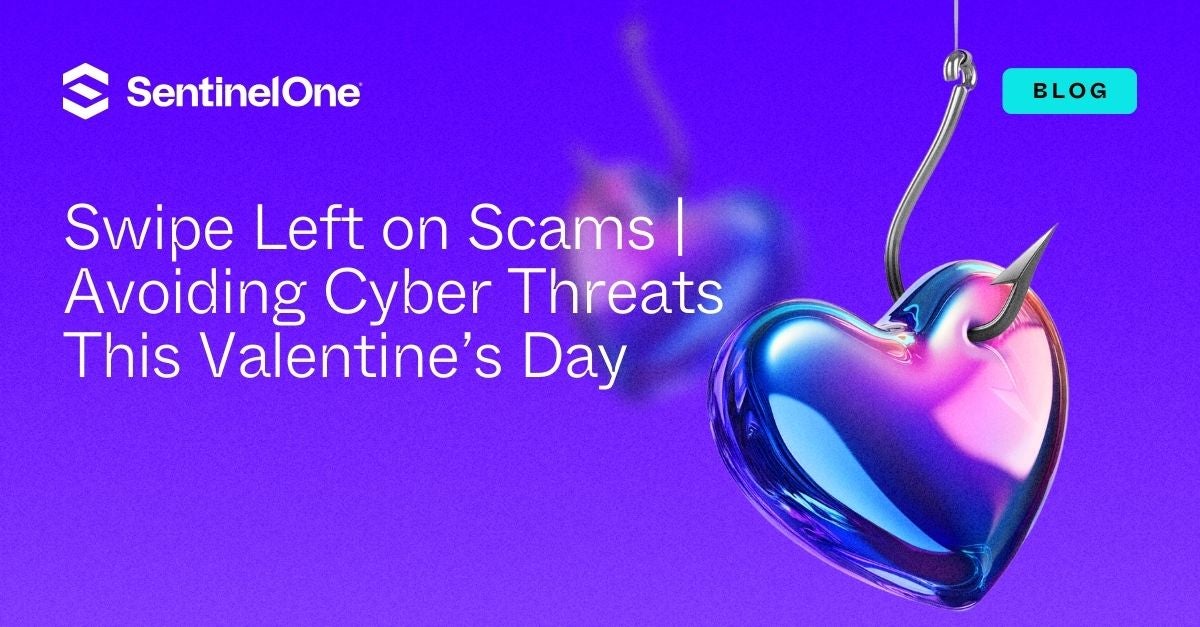Valentine’s Day is a time for romance, but for cybercriminals, it’s just another opportunity to exploit emotions, urgency, and trust for financial gain. Threat actors don’t take holidays off – in fact, they ramp up their efforts during festive seasons, leveraging current events and trends to lure unsuspecting victims. Whether it’s fake flower deliveries, romance baiting scams, or phishing campaigns disguised as last-minute gift promotions, attackers are constantly adapting their tactics to the world around them.
Holidays like Valentine’s Day present cybercriminals with ideal conditions for social engineering attacks. With people eager to gift-give or enjoy a great deal may be more likely to fall for well-crafted scams. Cybercriminals use this to their advantage, testing new and innovative methods while also relying on tried-and-true schemes that continue to work year after year. Threats like fake dating profiles, malicious e-cards, and spoofed online store promotions are all designs to deploy malware or extract sensitive information from those being targeted.
Understanding the most common scams, such as romance fraud, phishing attacks, and fake charity appeals, can help individuals and businesses avoid falling victim. This blog post covers the top threats to watch for and how to stay one step ahead of cybercriminals by staying vigilant.

From Love to Loss | Romance Baiting Schemes
Romance baiting, formerly referred to as “pig butchering”, is a highly manipulative form of online fraud that preys on victims’ emotions and trust. These scams typically start with fraudsters approaching targets through social media, dating apps, or messaging platforms, under the guise of forming genuine relationships. Over time, they build rapport, gaining the victim’s confidence through long-term conversations and fabricated emotional connections. However, the ultimate goal isn’t romance – it’s financial exploitation.
Once a victim’s trust is secured, the scammer introduces fraudulent investment opportunities, often involving cryptocurrency or other financial ventures. They convince the victim that they can achieve high returns, sometimes even showing fake profits to reinforce credibility. The target, believing they are making a secure investment or helping a loved one, transfers money into accounts controlled by the fraudsters. As the scam progresses, the victim is encouraged to invest more until they’ve given significant sums. Then, without warning, the scammer disappears, taking the money and severing all contact.
The FBI has reported a sharp increase in these scams over recent years, with investment fraud losses rising from $3.31 billion in 2022 to $4.57 billion in 2023. Beyond financial loss, romance baiting scams often cause significant emotional and psychological harm. Victims often suffer deep stress and trauma upon realizing they were deceived by someone they trusted. In some cases, the emotional toll has been so severe that victims have taken their own lives.
Interpol now advocates for the term “romance baiting” to replace the stigma behind the original term, “pig butchering”, shifting the focus from victim-blaming to the calculated deception used by fraudsters. Encouraging victims to come forward without shame is crucial and timely reporting can help prevent future scams and aid in tracking cybercriminals. Awareness and education remain the best defenses against these devastating schemes.
A Valentine’s Day Trap | Holiday-Themed Gift Card Scams
Gift cards are a popular choice for last-minute Valentine’s Day shoppers, making them a prime target for scammers. Every year, cybercriminals take advantage of the holiday rush by crafting scams aimed to trick victims into giving up personal information or sending money. One of the most common schemes involves fraudulent gift card promotions, where victims receive emails, text messages, or social media ads claiming they’ve won a special Valentine’s Day deal. These messages often contain links urging recipients to “claim your exclusive Valentine’s Day gift card” or “redeem your romantic getaway now”.
Clicking the malicious links typically lead to spoofed websites designed to steal personal details, credit card information, or login credentials. In some cases, the site may prompt victims to enter payment information to cover a “small processing fee”, giving scammers direct access to their financial accounts. Another version of this scam involves phishing emails impersonating major retailers, suggesting that a gift card purchase needs verification or that an unclaimed reward is about to expire.
Beyond digital fraud, scammers also use social engineering tactics to convince victims to buy and send gift cards directly. A common trick involves scammers posing as loved ones or even employers, urgently requesting a Valentine’s Day gift card as a favor. Once the victim shares the card details, the scammer drains the balance and disappears.
Always verify the source of unexpected gift card offers, avoid clicking on suspicious links – especially ones that you are not actively expecting. When purchasing gift cards, do so only from reputable retailers. If an email or text seems too good to be true, it probably is.
Fake Downloads, Real Threats | Malicious Valentine’s Day Downloads
Cybercriminals love to take advantage of seasonal trends, and Valentine’s Day is no exception. One rising tactic they use involves malicious downloads disguised as festive digital content, easily shared via email or chat apps used between couples, friends, and family members. Whether it’s themed wallpapers, e-card generators, or the occasional themed online quiz or calculator, scammers create downloads laced with malware ready to infect unsuspecting users’ devices.
Downloads are often promoted through phishing emails, fake social media ads, or unofficial app stores. A common trick is offering exclusive Valentine’s Day wallpapers or personalized e-cards that require users to install a small program. However, hidden within these downloads are trojans, spyware, or ransomware designed to steal personal data, track online activity, or lock files until a ransom is paid. Some apps even grant attackers remote access to a victim’s device, allowing them to steal credentials or spread malware further.



Most typically, examples of these malicious drive-by (aka manual) downloads come in the form of generic infostealers and backdoor trojans. Whilst these may be considered ‘commodity’ level threats, they result in the ongoing feeding of the infostealer economy and markets founded on selling stolen credentials and data. One particularly concerning threat is malware-laced Android or iOS apps promising holiday-themed games, stickers, or emojis. Users who sideload these apps from untrusted sources risk exposing their data, including banking credentials and private messages.
Stay safe by avoiding Valentine’s Day-themed software from unknown sources, stick to official app stores, and be cautious of email attachments or links promoting “must-have” holiday downloads. Stick with reputable platforms if sending e-cards or downloading wallpapers and skins for your devices.
Digital Love or Digital Fraud? | The Cyber Risks of Online Dating
Cuffing season may be wrapping up, but cybercriminals know that Valentine’s Day brings a surge of users to dating apps like Tinder, Hinge, and Bumble. Scammers ramp up phishing and bot activity during this season, using fake profiles to lure victims into fraud schemes, steal personal information, or even commit identity theft.
One well-used tactic involves bots or fraudsters posing as potential romantic interests, engaging in conversation to build trust. Once rapport is established, they often pivot to phishing scams – sending links to fake dating verification pages, supposed “gift exchanges”, or exclusive Valentine’s Day offers. These links may steal login credentials, banking details, or install malware on the victim’s device. Identity theft on dating apps is also a growing risk. Scammers may request photos, personal details, or even ID verification under false pretenses, using the stolen information for fraudulent activities down the line.
Be cautious of overly eager matches, avoid clicking suspicious links, and never send money or personal information to someone you haven’t met in person. If a conversation feels rushed or too good to be true, trust your instincts – cybercriminals are hoping you won’t.
Conclusion
Threat actors are constantly refining their tactics, taking advantage of seasonal trends and holidays to lure in unsuspecting individuals. Though scams occur year-round, cybercriminals seize opportunities like Valentine’s Day to exploit emotions, trust, and urgency. From romance baiting and investment fraud to phishing scams and malicious downloads, the risks can lead to heartache but are avoidable with the right amount of awareness and caution.
Stay skeptical of unsolicited messages, verify online connections, and never send money, cryptocurrency, or personal information to someone you haven’t met in person. If an offer or interaction seems too good to be true, assume that it is.
By staying informed and practicing good cybersecurity hygiene, enjoy Valentine’s Day without falling victim to fraud. If you suspect a scam, report it to the appropriate authorities – your vigilance could help prevent others from being targeted.


